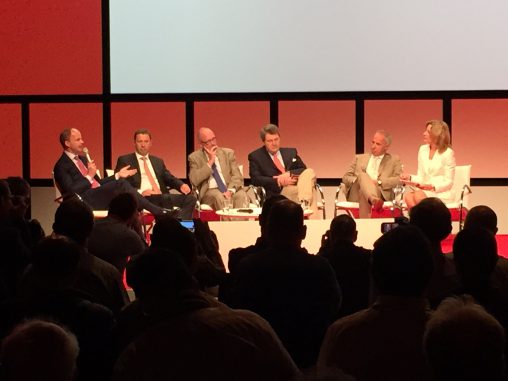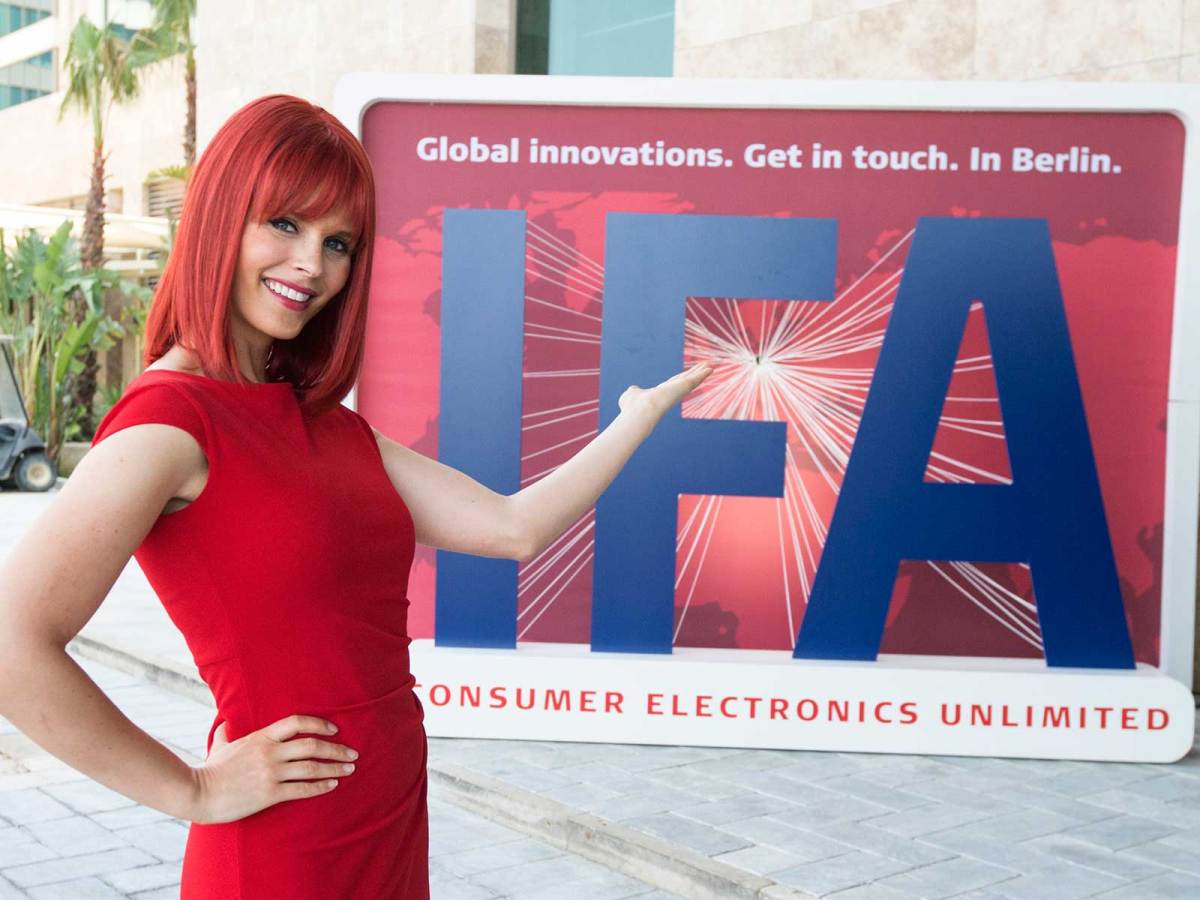This author is on Twitter: @Patrickavenell
Malta

A phantasmagoria of new products, technology and initiatives is expected to be unveiled when the world’s leading brands, dealers, thinkers and media descend on Berlin in September for the 2015 Internationale Funkausstellung, better known as IFA, the build up to which was officially launched in Malta today (Saturday 25 April 2015).
The Mediterranean island nation – the only country to have been collectively awarded the George Cross – has this week been hosting the 2015 IFA Global Press Conference. It’s a meeting of leading brands, including Microsoft, Philips, Dyson, Miele, Haier and Grundig, and journalists from all of the world to discuss the trends and developments expected through the rest of the year. This mini-IFA is made of two parts: power briefings from sponsors and the actual Press Conference.
It’s a sounding board of ideas and predictions for what will actually take place at IFA, which has grown considerably over the past decade, transitioning from a largely German trade fair to a European one to a truly global event. In addition to the brands mentioned above, all the leading players are expected to exhibit, from the Korean powerhouses Samsung and LG to the Chinese upstarts Changhong and TCL and, of course, all the major European technology and appliance manufacturers. The only brand of note that will demur is Apple.
This is the ninth IFA Global Press Conference and its purpose is to start drumming up international interest in the September event. It’s no coincidence that the existence of the Press Conference has run concurrent to a dramatic upswing in international relevance for IFA proper. Over the coming weeks and months, articles will be published in technology journals around the world discussing and promoting the expo from a global perspective, encouraging delegates from far flung places to book their tickets and pack their bags. It certainly helps that over the past few IFAs, we’ve seen major product announcements from Sony, Miele, and Samsung, to name but a few. Those who have been to IFA talk of its hectic wonder: a smashing together of the brightest minds with the collaborative goal of growing the industry. The order books are open and the message is loud and clear: this is an outcome-based fair. Deals will be done on stands and orders fulfilled for the Christmas rush, at least for the Europeans. The globalisation of the industry means Australia is never too far behind.
Throughout the power briefings conducted by brands and analysts during the build up to the eponymous Press Conference in Malta – and whilst not all powerful they were at least mercifully brief – several key trends have emerged. Wearables that provide a utilitarian benefit to the user will win out over novelty releases. The Internet of Things will continue to shape research and development but consumers need a convincing connectivity story to fully embrace the idea – it is simply not good enough to have a washing machine that can talk to an oven – the process must make lives simpler. The drive towards energy and water efficiency is not set to abate. Robotics and automation will be huge.
Dr Christian Göke is the CEO of Messe Berlin, the organising company behind IFA. He started by explaining how much the industry has changed over the past 35 years, driven largely by dramatic decreases in prices of technology products. In 1980, he said, a new TV cost an average month’s wage in Germany, whereas today it is, roughly, only a week’s wage. Self evidently this is good for consumers but Göke said it has been a challenge for manufacturers, and he rattled off a list of once famous household brands, Toshiba and Metz among them, that have been unable to adapt.
“We try to absorb this continuous change and we try to integrate this continuous change into the IFA show,” Göke said, before revealing some actual details. “A third of the show will be the TV and Home Entertainment category. The biggest growing section will be components, followed by Media and Communications.”
Göke was very pleased to reveal that, for the first time, Whirlpool will be bringing its complete brand portfolio, including Indesit, KitchenAid and Blaupunkt, while a dedicated connectivity area will host Vodafone, T-Mobile, HTC and ZTE, among others. Samsung will retain its prominent CityCube stand.
When asked about Apple’s continued absence from the show, there was mirth: “This is the first time I’ve been asked this question,” was the sarcastic but friendly response. The reason remains the same: while ever Apple has no need to court retailers, the Californian tech giant won’t see any reason to exhibit at IFA.
Across the show, almost 50,000 international trade visitors are expected, while visiting media representatives is expected to exceed the 2,600 that flew in to Berlin in 2014. Importantly for attracting international visitors, IFA will run concurrently with presentations by analysts groups GfK and IHS, as well as the Institute of Electrical and Electronics Engineers and zeitgeist-capturing gabfest TEDx Berlin.
Somewhat unusually, Göke chose not to reveal any keynote speakers for the show, simply saying that they will match the 2014 standard, which included executives from Samsung, Intel, Nest and Sennheiser. He did outline what the organisers see as the hot-button issues for the conference.
“Ultra HD screens with even more impressive colours and spectacular contrast, home cinema sound in three dimensions, innovative software platforms for intelligent interconnection, sensors for fitness and health, confectionery or fashion from the 3D printer, music from wireless networks: these are the latest consumer electronic trends.”
In a lovely moment of transparency, Göke said pricing for delegates will be frozen from the 2014 rates in order to encourage more visitors.
The first guest speaker at the IFA Global Press Conference was Jürgen Boyny, global director of consumer electronics, GfK Retail and Technology. He provided an overview of the global technology industry and provided some predictions as to where the market is heading.
“Connectivity is the theme for all the technologies we have at IFA. The show started as a consumer electronics show, now it is consumer electronics, telecommunications, domestic appliances and information technology. They are put together under one big theme: connectivity.
Boyny predicts a 1.5 per cent increase in the industry to 790 billion euro. “Conditions could be better, we have military conflicts that are disrupting the development of consumer electronics,” citing Russia, Ukraine, Syria and Africa. “The growth is being driven by the smartphone, which is connecting the dots between all these technologies.”
Region by region, Boyny predicted 2015 growth in the Middle East and Africa, emerging Asia and North America, steadiness in Latin America and a plateauing in Europe and developed Asia.
In major appliances, Boyny says there will be continuous growth in major domestic appliances, growing 3 per cent to 145 billion euro, while small domestic appliances will be “strongly positive”, growing by 4 per cent year on year. There is expected to be global growth in major appliances, save for Europe, which should ease slightly.
Breaking it down by category, increases in volume sales will more than make up for price declines through 2015, compared to the year prior. Smartphones will grow 8 per cent, LCD TVs will grow 2.3 per cent and tablets will improve by 1 per cent. Notebook and desktop PCs will slide 6 and 5 per cent respectively and digital still cameras will collapse, losing 15 per cent of its value compared to 2014.
Boyny directly addressed one of the biggest trends expected to be explored at IFA: wearables. He predicts 72 million units to be sold in 2015, up from 31 million in 2014. Then, in 2016, an avalanche: 114 million units are expected to cross the world’s counters. Most of these sales will be in smartwatches and health trackers, followed by wearable cameras, headsets and smart glasses. Soundbars and action cams are predicted to boom but the writing is on the wall for in-car GPS systems and e-readers, both of which are on longterm downward trends.
In TVs, growth is predicted in panels that are 50-inch and up, those with 4K Ultra HD and ones that include Smart TV connectivity. In emerging technologies, 2015 should see 3.9 million curved TVs and 400,000 OLED TVs sold.
On that topic, at an instructive session presented by analyst Paul Gray from IHS (née DisplaySearch) we were told that the 4K TV market will be driven by the take-up of streaming services like Netflix, which are the only platforms delivering Ultra HD content to the masses. But it is not simply a matter of stacking up the boxes and letting them sell themselves. His research indicates consumers can barely tell the difference between Full HD and Ultra HD in store. What they can discern, however, is an improved frame rate (“noticeable”) and a higher dynamic range (“very noticeable”). These are the kind of actionable insights readily available on the ground at IFA.
Potted History of DFA/IFA Exhibition
2015 will mark the 55th DFA/IFA conference. The show has had an interesting history since launching in Berlin 91 years ago.
1924: 242 exhibitors meet in Berlin for an 11-day conference on the development of radio engineering. It was called the DFA, standing for ‘Deutsche Funkausstellung’, literally German Radio Exhibition.
1925-1939: The show is held annually in Berlin, coming under the patronage of the Third Reich’s notorious Minister of Propaganda Dr Josef Goebbels.
1940-1949: World War II and its aftermath interrupt the show.
1950: The expo returns, this time in Düsseldorf, with 211 exhibitors presenting across three halls. Düsseldorf would host the DFA again in 1953 and 1955.
1957: The organisers move DFA to Frankfurt, where it attracts 199 exhibitors but this number collapses to only 87 at the next show in 1959.
1961: Now being organised by the Television and Broadcasting Division of the Trade Association of the Electrical Engineering Industry, the DFA returns to Berlin, where numbers improve. Berlin hosts again in 1963.
1965: DFA goes on the road again, with Stuttgart hosting the conference for the first time. It returns to Berlin in 1967 and then back to Düsseldorf in 1970.
1971: The show rebrands itself the Internationale Funkausstellung (IFA) and settles into a permanent home in Berlin, where it is held biennially until 2005.
1979: A then-record 525 exhibitors attend the conference.
1995: 765 exhibitors from 30 countries make the shortest IFA on record — ‘only’ nine days — the busiest yet.
2003: The show downsizes its length again, to only six days, but IFA finally cracks the 1,000 exhibitor mark.
2005: IFA moves to an annual format.
2008: IFA welcomes home appliances into the show for the very first time, creating a “hitherto unprecedented level of product diversity”.
2010: The 50th edition of DFA/IFA sees 235,000 visitors attend the show.
2013: This edition had 1,500 exhibitors entertaining 240,000 visitors, of which 46,000 were international guests.
The 2015 IFA consumer electronics expo is being held in Berlin 4-9 September 2015.

